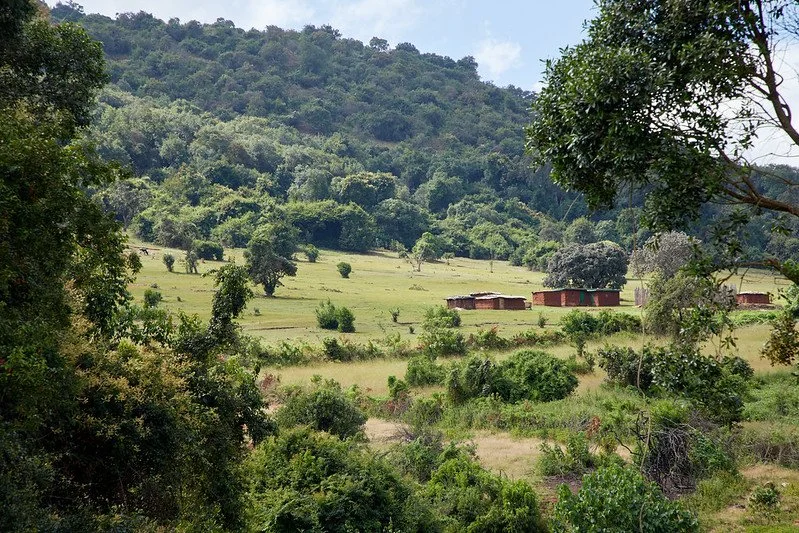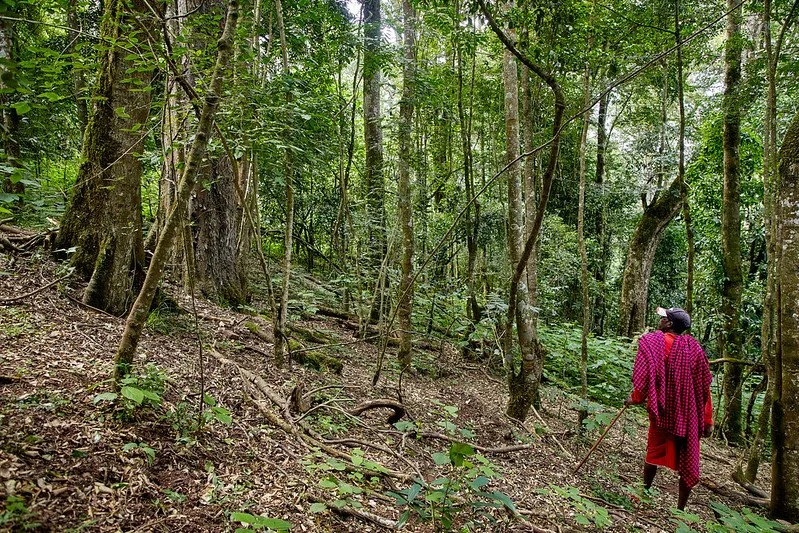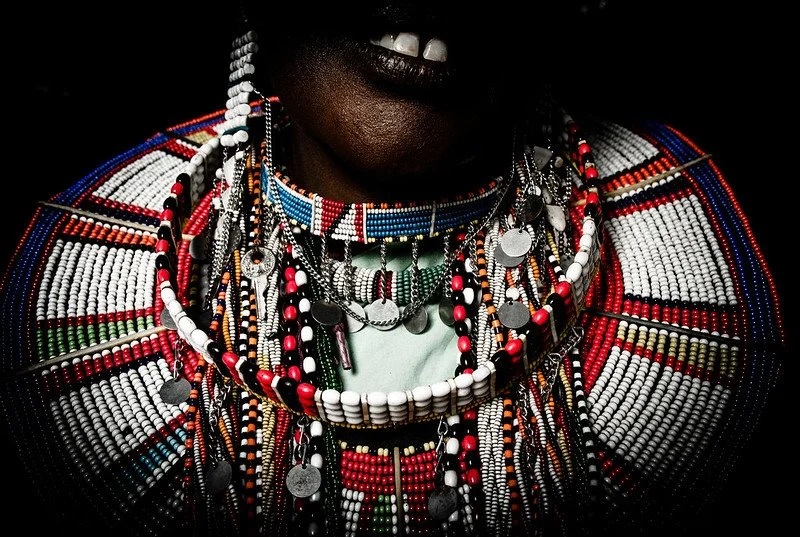Forest of the Lost Child & Maasai Homestays Itinerary
Day 1: Arrival and afternoon bush walk
We collect you from your hotel (or the airport) in Nairobi and drive (4.5hrs) to the village of Sekenani, which is right on the edge of the Masai Mara National Reserve, where you will meet the Maasai family who will be hosting you during your stay. After a healthy, home-made lunch, put on your walking shoes and our expert local guide will take you for a walk around the surrounding villages, the nearby market centre and out into the bush for a short nature walk. Bring binoculars to enjoy the fabulous bird life and likely sightings of larger animals. You will also learn how to track and identify animals from their footprints and the medical uses of many of the plants growing in the area.
Return to your host family for dinner.
Day 2: Cattle, lions and bush camping
Cattle are a big part of Maasai identity. Traditionally, the Maasai believe that Enkai (the Maasai god) gave all the cows in the world to the Maasai. In the not-so-distant past Maasai moran (warriors) would launch frequent raids on neighbouring tribes in order to steal their cattle. The logic being that the cows belonged to the Maasai anyway. Cattle raiding might be largely a thing of the past for the Maasai living in the vicinity of the Masai Mara but that doesn’t reduce the affection the Maasai show towards their livestock. So, it’s fitting that your second morning as a guest of the Maasai is spent with the livestock (this can be cows, sheep or goats depending on the grazing patterns at the time of your visit). The first job is to help hand milk the livestock, sort the youngsters from the adults and then, after a quick breakfast, set out with the livestock to the grazing grounds in the nearby countryside. This is a unique experience that will give you real insight into Maasai life.
Returning to the homestay we can either join Maasai women in a beadwork class during which the ladies will help you to create some of the distinctive Maasai jewellery. Or, if it’s a Sunday, we can head to church. A Kenyan church service is a highly colourful (and often noisy) spectacle. In addition to enjoying the singing and dancing at the church service our guide will teach you about the old Maasai religion of Enkai, which today has been largely replaced with Christianity.
In the afternoon we set out on a thrilling wildlife safari in the Masai Mara National Reserve with our Massai hosts. The Masai Mara is famous for its big cats and you would be very unlucky to not see at least one group of lions. Leopard and cheetah are both commonly seen. You will almost certainly see elephants as well warthogs, zebra, giraffe, hyena, baboons, ostrich and huge numbers of antelope and gazelle of various species.
In the early evening, we arrive at our remote bush camping site set in a quiet corner of the Mara grasslands. Your guides will put up two-man dome tents and prepare a delicious dinner while you enjoy a sundowner drink listening to the sounds of the African evening. For most guests this one of a kind wilderness experience is the highlight of a Kenyan holiday.
Day 3: Safari and meet the community
Waking up on the savannah plains, we have a quick coffee or tea before setting out on a morning game drive within the Masai Mara National Reserve. Our expert guide will reveal the wonder of the Mara grasslands to you. Wildebeest are present year-round but between July and early-October the population swells enormously as the million strong herds of migrating wildebeest arrive from Tanzania’s Serengeti National Park. Seeing such huge numbers of large mammals gathered together is a moment you’ll never forget.
Return to the bush camp for a hearty breakfast before a slow safari-style drive back to the homestay. There will likely be plenty more thrilling wildlife sightings along the way.
After a tasty lunch it’s time to get a deeper understanding of the Maasai people. Most safaris limit themselves to a quick visit to a ‘cultural village’ where people dress as Maasai morans (warriors) and regale you with tales of hunting lions with spears. However, almost all of this is just put on for the tourists. What we are going to reveal to you is a totally different and completely genuine look at contemporary Maasai life – with warts and all - on the edge of the Masai Mara. A percentage of the money you paid for your safari is going toward supporting a number of small, locally run projects and our local guide will take you to see some of these (exact itinerary depends on the time of year and what’s happening that week). Examples could include a visit to the local clinic or school, or we could pop by the orphanage to meet some of the children. Many of these orphans are not technically orphans but are young girls who have run away from their family in order to avoid a forced marriage (forced marriages are illegal in Kenya but continue in remote areas).
Day 4: Journey to the Forest of the Lost Child
On day four we set out into one of the least known corners of Kenya. Rising up east of the Masai Mara, is a range of low scrubby hills (often, wrongly, called the Loita Hills). As you travel east, the hills rise higher and the landscape turns greener and thicker until, eventually, you are in the Loita Hills proper and the so-called Forest of the Lost Child. The landscape here is a tapestry of rainforest coated mountain slopes, deep river valleys and small villages surrounded by fields of crops. This is the most traditional remaining corner of Kenyan Maasai land and is unknown to most Kenyans - never mind foreign visitors. The drive from Sekenani to our simple tented camp in the forest takes about four hours without stops.
On arrival at our camp you’ll be served a late lunch before setting out with our local guides, who are all expert birders and know the footpaths through the forest better than anyone, on a two hour hike (level of difficulty of the hike can be adjusted depending on requirements of the group). Bring binoculars in order to benefit from the spectacular bird-watching and to get closer views of the beautiful black and white colobus monkeys swinging through the trees.
Day 5: Full day forest hike
Today, we will spend a full-day hiking through the forests, up to lofty summits and through traditional Maasai villages where the welcome is warm and outside visitors rare. Our local guides will point out colobus monkey, hornbills, and turacos as well as a wealth of other bird and animal life. We will also walk to a waterhole deep in the forest where forest buffalo (a different species to the buffalo seen in the savannah plains), bushbuck, forest pigs and even elephant sometimes congregate. As well as wildlife, the walk takes in tiny Maasai farming villages where invitations to stop and drink tea are very common. A picnic lunch will be eaten in the forest or at one of the viewpoints. The exact length and difficulty of the walk can be tailored according to the ability and wishes of the group.
On certain days of the week an important regional market takes place in the village close to our camp. If it’s taking place during our visit we will make time to visit and meet Maasai from across the region and even nearby Tanzania.
There will be some time to relax and enjoy this wonderfully peaceful setting before sundowner drinks and dinner.
Day 6: Bird watching or beading. Travel to Naivasha
This morning we visit a small swamp which was once highly degraded, but that now, thanks to the hard work of a local Maasai conservation group, has been restored and transformed into a rich bird habitat. We will then visit some of the community projects that are part funded by our stay in Loita. These include an award-winning school and a very successful beading and jewellery project. After an early lunch we drive (6hrs) to Lake Naivasha in the Rift Valley. This huge freshwater lake is known for its superb birdlife and large population of hippos. On arrival at our accommodation we will settle in and have dinner.
Day 7: Boating and cycling, Lake Naivasha
The beautiful, freshwater, Lake Naivasha is known for its superb birdlife and large population of hippos. In the morning we will go for a walking safari in the Crescent Lake reserve (which is reached via a short boat ride). There are no predators on the island so you’re free to walk as you want among herds of bushbuck, zebra, giraffe and ostrich. Then, after a tasty lunch, we go for an afternoon cycle or hike through Hells Gate National Park, which has large numbers of gazelle, antelope, zebra, giraffe and baboon.
Day 8: Street kids tour and giraffes, Nairobi
After breakfast we drive back to Nairobi (around 2.5hrs). As soon as we arrive back in the city we will join former street kids (homeless children who live on the streets) for a unique walking tour of Nairobi during which your guide will recount the story of their life on the street and show you a side of East Africa’s most important city that few foreigners get to experience. After lunch in a local cafe we will head to the giraffe sanctuary where you can get up close and personal with the rare Rothschild giraffe. There’s also the opportunity to go for a short bush walk inside the sanctuary or visit some nearby craft shops. At the end of the day we drop you at your hotel or the airport where this safari ends.







